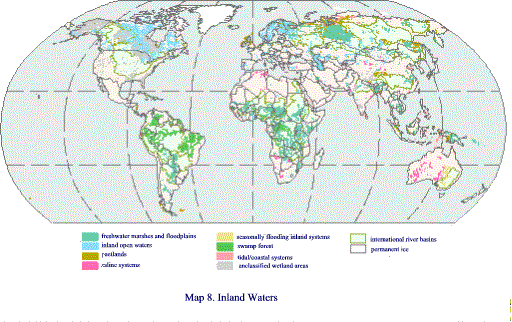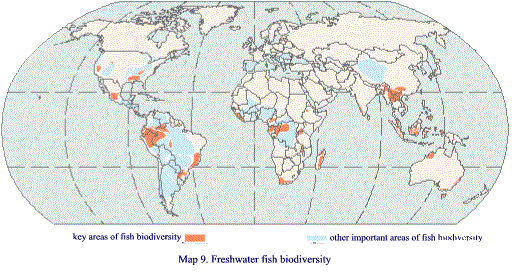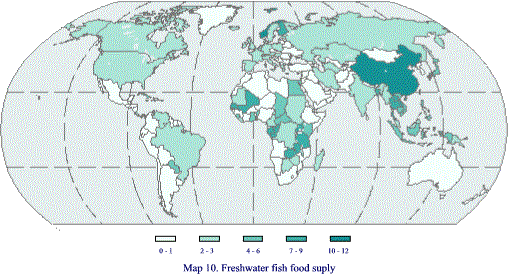TRENDS IN ECOSYSTEM DIVERSITY
Biodiversity of Inland Water Ecosystems
Freshwaters make up less than 3% of the total volume of water on Earth. They consist largely of water in the form of polar ice (mostly Antarctica) and groundwater, i.e. water below the Earth's surface held within rocks or between rock strata and constituting perhaps 30% of global freshwater resources. Water in lakes and rivers constitutes less than one-hundredth of one percent (<0.01) of the world's total water volume, and around a quarter of one percent (<0.27) of global freshwater volume. Lake water is the largest component in this vanishingly small subtotal.
Table 1.6
The world water resource | |
| |
Area
(million km2) |
% total area |
Volume
(million km3) |
% total water |
% fresh water |
| Earth surface |
510 |
|
|
|
|
| Land |
149 |
29 |
|
|
|
| World ocean |
361 |
71 |
1338 |
97.5 |
|
| Fresh water: |
- |
- |
35 |
2.5 |
|
| Ice |
16 |
- |
24 |
1.75 |
69 |
| Ground water |
- |
- |
10.5 |
0.75 |
30 |
| Wetlands * |
2.6 |
- |
0.01 |
0.0008 |
0.03 |
| Lakes |
1.5 |
- |
0.09 |
0.007 |
0.26 |
| Rivers |
- |
- |
0.02 |
0.0002 |
0.006 |
Notes:
* all estimates are approximations and vary according to the methods used to derive them; for consistency we have taken data from a single source.
* in the traditional sense, i.e. marshes, swamps, mires, lagoons, floodplains etc;
** excluding saline lakes.
Source: Anon. (USSR Committee for the International Hydrological Decade) 1978.
The more superficial groundwater deposits are linked to the global water cycle, and are used for human consumption or agricultural purposes, whereas the deeper layers tend to be somewhat saline and do not (except over geological time scales) participate in exchanges with other parts of the system.
Inland aquatic habitats show far more variety in their physical and chemical characteristics than marine habitats. They range from vast, permanent lakes and rivers to geothermal springs, temporary puddles and minute pools and from almost pure water to highly concentrated solutions of mineral salts, toxic to all but a few specialised organisms.
Inland aquatic habitats can be divided into running or
lotic and standing or
lentic systems. They may also be divided into permanent water bodies, periodically (usually seasonally) inundated and transient or ephemeral. There is no rigid dividing line between an inland aquatic habitat on the one hand and a terrestrial or marine habitat on the other. Seasonally inundated areas, such as river floodplains, are effectively hybrid or transitional systems. There are also many areas that consist of shifting mosaics of land and shallow water, or areas of saturated vegetation, such as sphagnum moss bogs, that are neither strictly land nor water. There areas are often termed “wetlands”.
Major inland water systems
Rivers and other lotic systems are essentially linear bodies of water draining under the influence of gravity from elevated areas of land towards sea level. River systems typically branch into ever smaller and more numerous channels with increasing elevation. The volume of water and speed of flow usually varies greatly from one part of a river system to another. These factors also vary seasonally; in some arid areas rivers flow for only part of the year, or in extreme cases only once in several years. Variations in water flow and in underlying geology create a wide range of habitats within any river, often within a short distance. Large river systems may also span many degrees of latitude and pass through a wide range of climatic conditions within their catchments. This variation creates a wide range of niches for different organisms within any given river system. Although river systems are constantly changing their courses, sometimes radically, through deposition and erosion of channels and the uplift and erosion of watershed uplands, evidence suggests that many larger river systems are extremely old, with some having been in continuous existence for tens of millions of years.
Lakes of which around 10,000 exceed 1 km
2 in extent, are mainly glacial in origin and geologically very young, dating from the retreat of the continental ice-sheets at the start of the Holocene, some 11,500 years before present. All such lakes are expected to fill slowly with sediment and plant biomass and to disappear within perhaps the next 100,000 years, along with any isolated biota. Most other lakes are caused by tectonic activity, either through faults caused by deep crustal activity or through vulcanism. Lakes may also be formed by dissolution of soluble rocks (for example limestone in karst regions) or by changes in the course of rivers in floodplain regions. Only around ten existing lakes are known with certainty to have origins much before the Holocene. Most of these occupy basins formed by large-scale subsidence of the Earth's crust, dating back to at most 20 million (Lake Tanganyika) or 30 million (Lake Baikal) years before present
Wetlands are traditionally understood as heterogeneous habitats of permanent or seasonal shallow water dominated by large aquatic plants and broken into diverse microhabitats. The four major habitat types are:
- Bogs, which are peat-producing wetlands in moist climates where organic matter has accumulated over long periods. Water and nutrient input is entirely through precipitation. Bogs are typically acid and deficient in nutrients and are often dominated by sphagnum moss. They are also important habitats for carnivorous plants. In many places they are endangered by the extraction of peat for horticulture.
- Fens are peat-producing wetlands that are influenced by soil nutrients flowing through the system and are typically supplied by mineral-rich ground water. They are usually more productive and less acidic than bogs.
- Marshes are inundated areas with herbaceous emergent vegetation, commonly dominated by grasses, sedges or reeds. They may be either permanent or seasonal and are fed by ground or river water, or both.
- Swamps are forested wetlands on waterlogged or inundated soils where little or no peat accumulation occurs. Like marshes they may be either seasonal or permanent.

Diversity in inland water ecosystems
At higher taxonomic levels, the diversity of organisms in inland waters is considerably lower than on land or in the sea. The number of species overall is also low compared with marine or terrestrial habitats; however, species richness compared to habitat extent may be very high. For example, of known fish species around 40% (
ca 10,000) are freshwater forms and 60% marine, despite the fact there is around 10,000 times as much seawater as there is water in inland water habitats. This high diversity of inland water fishes relative to habitat extent is undoubtedly promoted by the extent of isolation between inland water systems. As is the case with terrestrial habitats, species richness overall increases strongly toward the equator, so that there are far more species in tropical than in temperate or polar regions (Map 9). Among river systems, the Amazon-Ucayali is both by far the largest river catchment in the world, holding the greatest volume of water, and is also wholly within the tropics. Unsurprisingly, it is the major repository of the world's inland water biodiversity, although it remains very incompletely catalogued. Among lentic systems, the most diverse are the large African rift valley lakes, notably Tanganyika, Victoria and Malawi.

Major values and uses of inland water ecosystems
Freshwater - as precipitation, groundwater or in inland water ecosystems - is essential for human survival, chiefly because humans must drink and also because it is needed, in far greater quantity, to produce food. Inland fisheries, particularly in land-locked less-developed countries, are extremely important to human nutrition, and fish protein may be critical in times of food stress (Map 10). The relative contribution of inland fisheries is, however, impossible to assess accurately because so much of the catch is consumed locally and not reported in official statistics.
Major uses of inland waters include:
- provision of freshwater for drinking, agriculture, industrial production, cleaning and other purposes;
- harvest of species for food, clothing, medicines, building material, horticulture and live animal trade;
- waste disposal;
- transportation;
- generation of hydroelectric power;
- recreation.

Major impacts on inland water ecosystems
Inland waters have in many areas suffered as a result of the conflicting interests of different sectors. Physical change to freshwater habitats is a prime cause of decline and extinction of fish species, but may provide benefits, such as hydroelectric power, to human populations. Dam construction is the chief cause of extinction in the formerly large gastropod fauna in Mobile Bay (USA), for example. The introduction of alien species is a second prime cause of decline: the impact of Nile Perch on the native cichlid fauna in Lake Victoria is well documented. Overall, the major kinds of impact on inland waters are:
- physical alteration and destruction of habitat through abstraction of water, drainage, canalisation, and flood-control systems,
- construction of dams and reservoirs
- sedimentation
- introduced species
- pollution, including: eutrophication, acid deposition, salinisation, heavy metals,
Status and trends of species in inland waters
In those relatively few cases where detailed studies have been carried out, it has been found that the status of inland water faunas has been considerably worse than originally suspected. Of the 20 or so countries that have been reasonably comprehensively assessed, on average just under 20% of the inland water fish fauna has been found to be threatened. The proportion of inland water chelonians (tortoises and turtles) threatened is even higher, with more than 30% of species having been assessed as critically endangered, endangered or vulnerable. Amongst birds and mammals the proportions are considerably lower, probably because many semi-aquatic species are able to disperse relatively easily from one inland water body to another.
The two major documented extinction events in the twentieth century both took place in inland water ecosystems. Lake Victoria, shared by Kenya, Tanzania and Uganda, was until recently the home of a species flock of around 300 halpochromine cichlid fishes, of exceptional scientific interest, as well as of a number of other fish species. Following introduction of the Nile Perch
Lates niloticus, and possibly also as a result of a range of other factors, at least half and up to two-thirds of the native species are now believed extinct or nearly so, with virtually no chance of recovery. In the Mobile Bay drainage in the USA, dam construction has had a catastrophic impact on what was probably the most diverse freshwater snail fauna in the world. Nine families and around 120 species were known from the drainage basin. At least 38 species are believed to have become extinct in the 1930s and 1940s following extensive dam construction in the basin: the system now has 33 major hydroelectric dams and many smaller impoundments, as well as locks and flood control structures. These patterns are likely to have been repeated at a smaller scale in many other less well-documented parts of the world.
A common finding among global assessments of the status and trends of biological diversity is that inland waters are those suffering the greatest deleterious impact from human activities at present. Notes on a selection of the species that occur in inland waters and are categorised in the 2000 IUCN Red List as Critically Endangered, i.e. at highest risk of extinction, are provided in Table 1.7.
Table 1.7
Some Critically Endangered inland water animal species | |
| Mammals |
Baiji
Lipotes vexillifer |
A freshwater dolphin endemic to the Yangtze River, China. The fewer than 200 remaining individuals are threatened by entanglement in fishing gear, collisions with boats, pollution, and hydroelectric schemes. |
| Birds |
Brazilian Merganser
Mergus octosetaceus |
This little-known duck inhabits shallow, fast flowing rivers of eastern South America. Occurs in a few widely scattered populations, threatened by deforestation, hydroelectric development and hunting. |
| Reptiles |
Orinoco Crocodile
Crocodylus intermedius |
Restricted to the middle and lower reaches of the Orinoco River. Severely affected by commercial exploitation for skins from the 1930s through the 1960s; threatened by illegal hunting, pollution and loss of habitat. |
Striped Narrow-headed Softshell Turtle
Chitra chitra |
Restricted to the Mae Klong River basin (Thailand). Only a single population of 16 turtles is now believed to exist. Threatened by the domestic pet trade. |
| Amphibians |
Mount Glorious Torrent Frog
Taudactylus diurnus |
Known only from few mountain rainforest streams in southeast Queensland, Australia. Not found in recent searches, possibly extinct. Reason for decline not known. |
| Fishes |
Common Sturgeon
Acipenser sturio |
A large anadromous fish previously widespread in large European river basins. Following habitat loss, pollution and overfishing the species now spawns only in the Gironde-Garonne-Dardogne basin of France and the Rioni basin of Georgia. |
Cave Catfish
Clarias cavernicola |
Endemic to Aigamas Cave lake, near Otavi, Namibia. The small population of catfish (<400 individuals) is threatened by a decrease in water level resulting from the depletion of local aquifers. |
Lake Victoria cichlid
Macropleurodus bicolor |
One of the many cichlid fishes endemic to Lake Victoria, east Africa. The introduction of the predatory Nile Perch, together with intensified fishing efforts appear to be responsible for the decline in this particular species. |
| Crustaceans |
Shasta Crayfish
Pacifastacus fortis |
A small crayfish limited to the Pit River basin, California, USA. The few remaining populations are threatened by introduced crayfishes, stream modification and pollution. |
| Molluscs |
Rough Pigtoe
Pleurobema plenum |
Formerly present in larger river systems of the eastern United States, this mussel is now restricted to a few sites in Alabama, Kentucky and Tennessee. Decline attributed to pollution and habitat loss. |